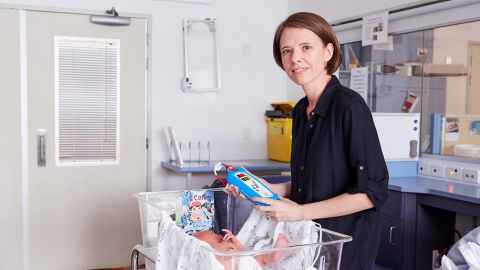Babies missing out on heart screening
23 August 2019
Newborns are missing out on potentially life-saving screening for a heart defect, with unequal access to the test across district health boards and population groups.

The test, called pulse oximetry, is routinely used in parts of Australia and in several other countries, and the Ministry of Health is considering introducing it throughout Aotearoa New Zealand. Universal pulse oximetry screening could prevent the deaths of four babies a year here.
The study, led by researchers at the University of Auckland-based Liggins Institute, investigated the success of trials of the screening at Auckland, Counties Manukau Health and Lakes District Health Boards. Researchers especially wanted to understand the potential challenges of bringing in a national screening programme.
They found that Māori and Pacific babies, babies from low-income families and babies born at Counties Manukau Health were less likely to be screened compared to other groups.
Study lead, neonatologist and Liggins Institute PhD student Dr Elza Cloete, says the reasons for these disparities are to do with regional midwife shortages, the fact that midwives in general are overstretched and under-resourced, and specific institutional issues.
Researchers say pulse oximetry screening needs to be nationally-led and properly resourced to avoid “significant inequities”, rather than relying on each district health board to introduce screening on its own.
Our study shows that newborn pulse oximetry screening can be delivered here, but only if the midwives are adequately resourced, as they are the best ones to do the screening
Pulse oximetry is used to detect critical congenital heart disease (CHD), where the heart doesn’t form properly. The most common birth defect, CHD affects between four and 10 per 1,000 live-born babies. When CHD is picked up early – before or immediately following birth – and treated by surgery, survival rates are good.
Until recently, clinicians here had two ways of screening babies for the condition: an ultrasound during pregnancy, and a physical examination at birth. Although ultrasound can pick up the majority of cases, access to maternity ultrasound is variable; and physical symptoms often take 24 hours or more to manifest – long after most mothers and babies have gone home.
Pulse oximetry screening involves a small, band aid-like wrap being placed around the baby’s foot, with a light sensor inside that measures oxygen saturation in the blood. It’s a simple, non-invasive test that can be completed in a matter of minutes, and international evidence shows it can detect CHD that might be missed on clinical examination.
The study results have been published in Acta Paediatrica and BMJ Open. The study was carried out to help identify the best and fairest way of introducing pulse oximetry, and to identify the screening’s impact. Researchers gathered data from eight birthing centres in the North Island, including National Women’s Health at Auckland District Health Board and the primary birthing units at Counties Manukau Health (Papakura, Pukekohe and Botany Downs). Middlemore Hospital was unable to implement screening due to logistical and workforce issues.
The main findings were:
- Three babies with critical heart defects were identified following pulse oximetry screening, and a further 31 were identified with respiratory or infective diseases.
- Babies born at Counties Manukau Health were half as likely to be screened as babies born in Auckland District Health Board (38 percent versus 81 percent).
- Only about half of Māori and Pacific babies were screened compared with three-quarters of European and Asian babies. This ethnic disparity was greatest in Counties Manukau Health.
- Babies of mothers who did not register with a lead maternity carer (LMC) were less likely to be screened (30 percent compared with 83 percent of those registered with an obstetrician and 62 percent of those registered with a midwife).
- Babies who lived in an area in the lowest fifth of the New Zealand Deprivation Index were also less likely to be screened (47 percent for NZDep quintile 5 versus 76 percent for NZDep quintile 1).

Dr Cloete says there are several factors at play. “Midwives have numerous tasks to perform after the birth of a baby, sometimes 20 or more,” she says.
“Adding further tasks, such as pulse oximetry screening, places an extra burden on LMCs. The midwifery workforce in general believe that it simply is not possible to add more tasks without resourcing these adequately. Also, certain groups – such as Pacific women – are less likely to be registered with an LMC, and this carries through to a lower likelihood of their baby being offered and receiving screening.”
Professor Frank Bloomfield, Liggins Institute director and neonatologist at National Women’s Health at Auckland City Hospital, was the paper’s senior author.
“Our study shows that newborn pulse oximetry screening can be delivered here, but only if the midwives are adequately resourced, as they are the best ones to do the screening,” he says. “If this doesn’t happen, or if it’s left to each DHB to implement as it sees fit, there will be significant inequity in screening. Māori and Pacific babies, those born to poorer families and those living in certain health districts, will bear the brunt of this inequity.”
Dr Tom Gentles, director of the national paediatric cardiac service at Starship Child Health, says, “Our findings show how beneficial this screening can be – not just in diagnosing heart defects, but other respiratory conditions. Babies with serious heart problems are disadvantaged by delayed diagnosis, and pulse oximetry screening can reduce this. Every baby born in New Zealand deserves the advantage of early diagnosis via pulse oximetry screening.”
The research was funded by The Health Research Council of New Zealand, Starship Foundation, Middlemore Foundation, A+ Trust and Green Lane Research and Education Fund.
Read the articles
Acta Paediatrica: Pulse oximetry screening in a midwifery-led maternity setting with high antenatal detection of congenital heart disease
Media contact
Nicola Shepheard | Media Adviser
Tel: +64 9 923 1515
Mob: +64 27 537 1919
Email: n.shepheard@auckland.ac.nz